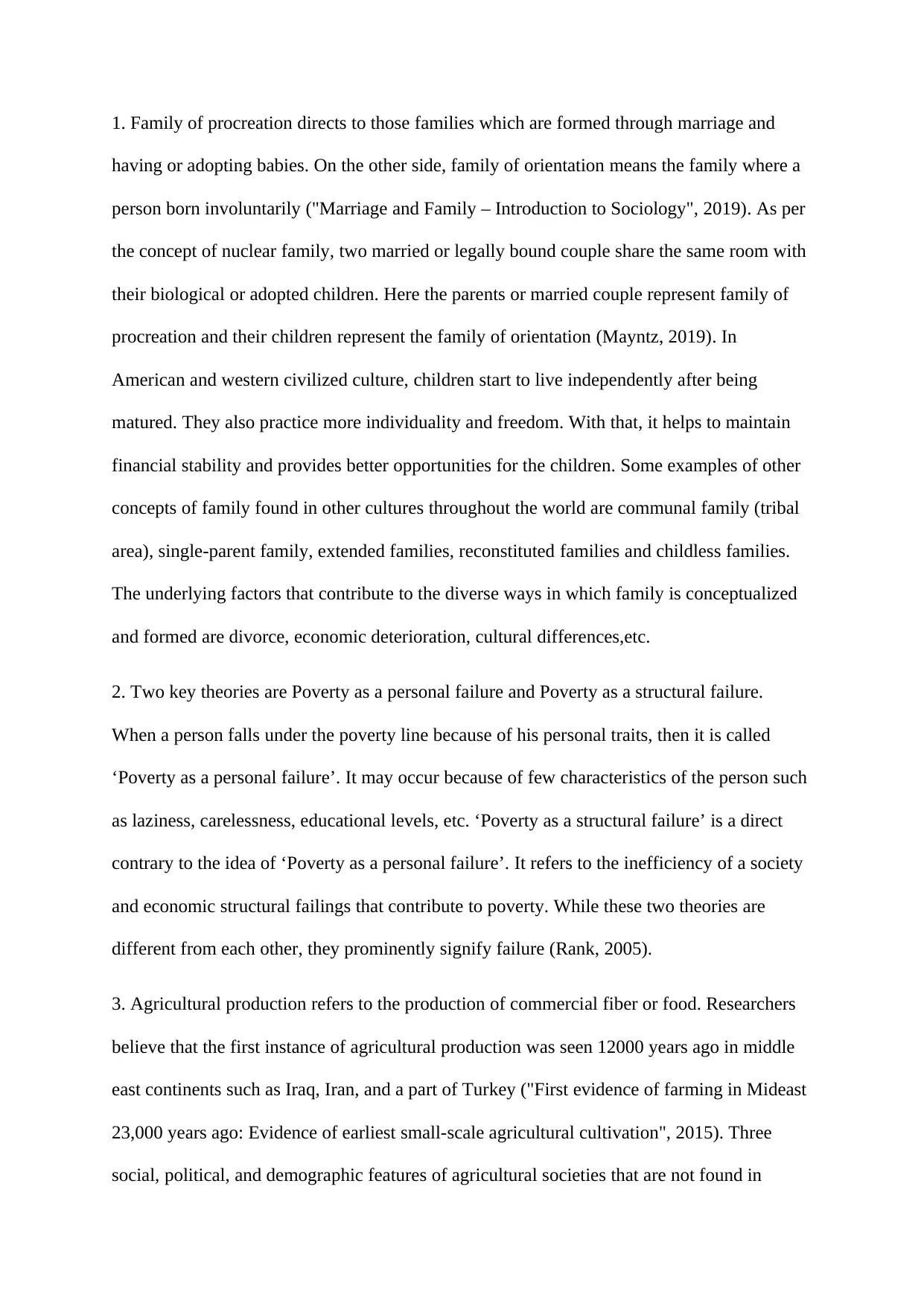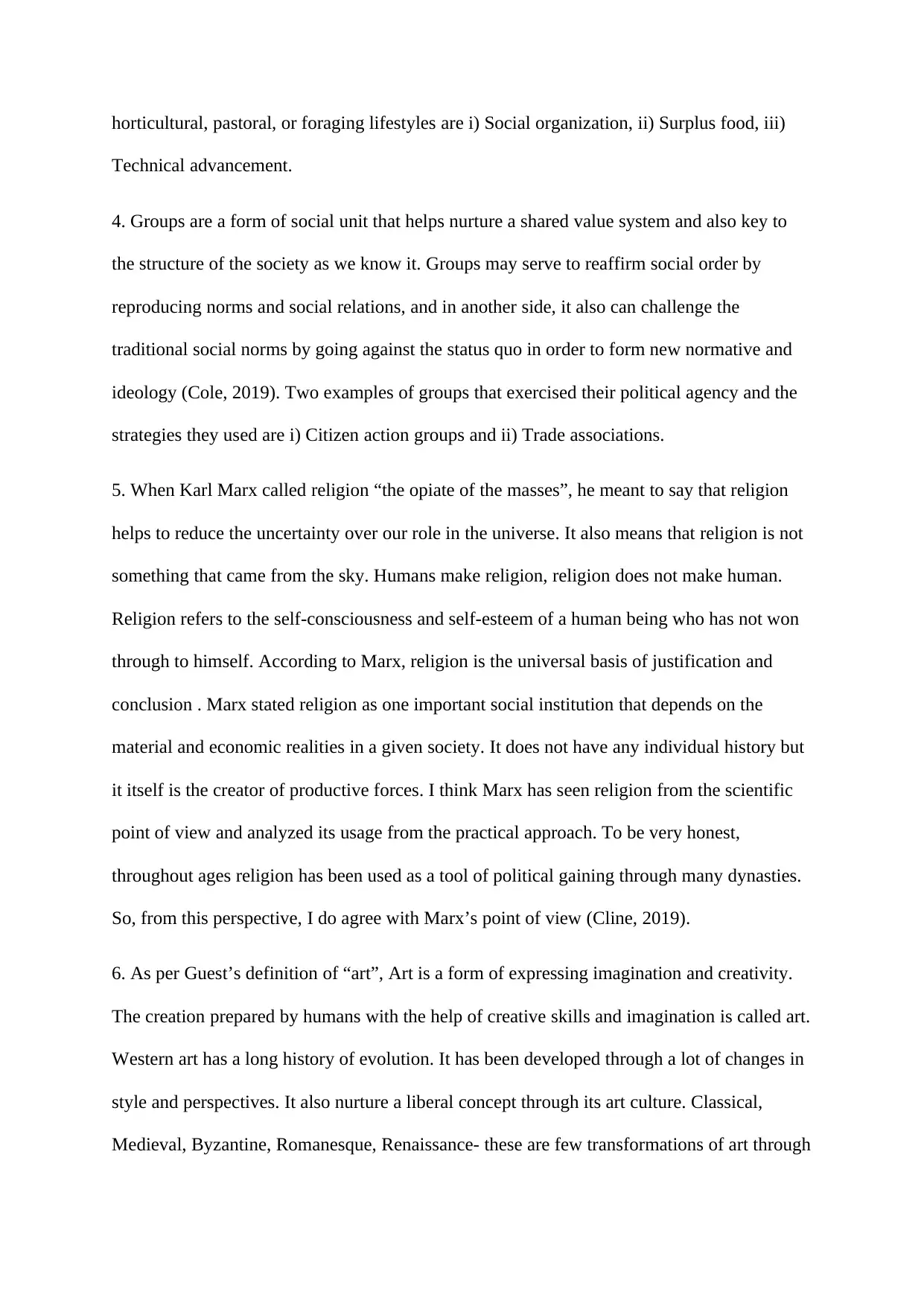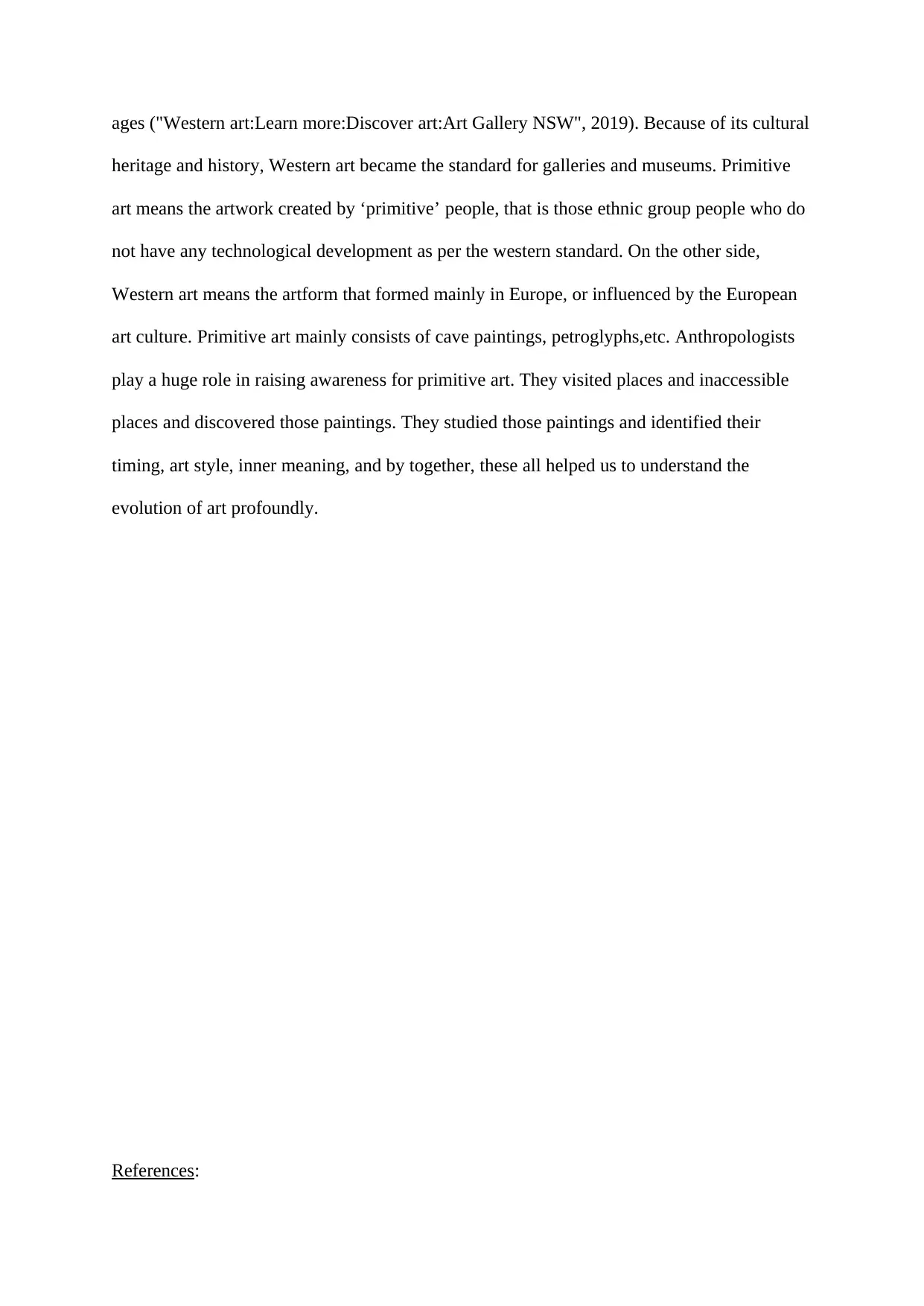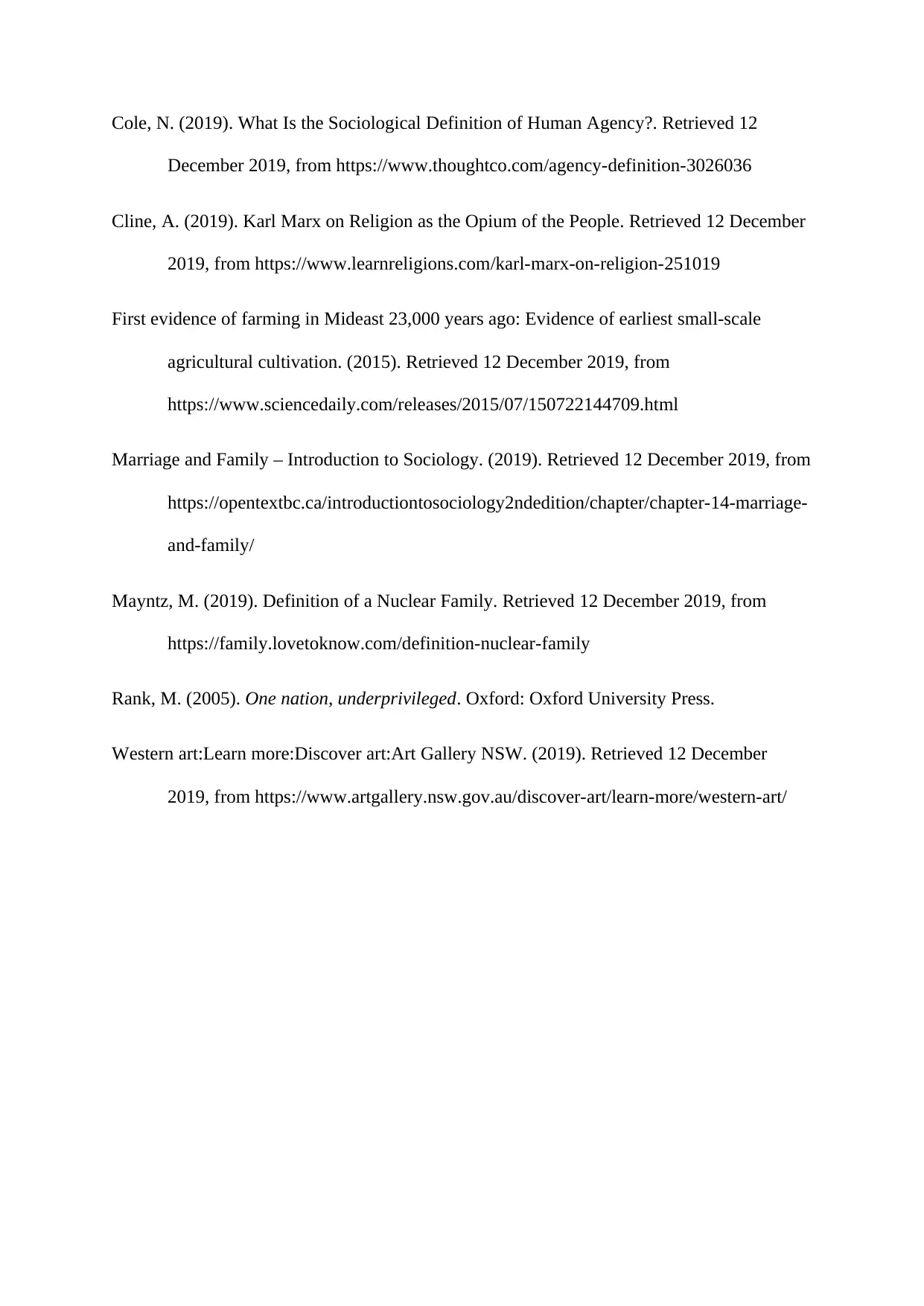Sociology Assignment: Family Structures, Poverty Theories & Art Forms
VerifiedAdded on 2022/09/11
|4
|1149
|19
Homework Assignment
AI Summary
This assignment delves into various sociological concepts, starting with family structures, differentiating between family of procreation and orientation, and exploring examples like nuclear, communal, and single-parent families, as well as factors contributing to their diversity. It then examines two theories of poverty: personal failure and structural failure. The assignment further analyzes agricultural societies, highlighting their social, political, and demographic features compared to other lifestyles. Additionally, it discusses the role of groups in society, including examples of political agency and strategies used by citizen action groups and trade associations. The assignment also presents Karl Marx's view on religion, describing it as the 'opiate of the masses,' and analyzes the concept of art, differentiating between Western and primitive art, and the role of anthropologists in its understanding.

1. Family of procreation directs to those families which are formed through marriage and
having or adopting babies. On the other side, family of orientation means the family where a
person born involuntarily ("Marriage and Family – Introduction to Sociology", 2019). As per
the concept of nuclear family, two married or legally bound couple share the same room with
their biological or adopted children. Here the parents or married couple represent family of
procreation and their children represent the family of orientation (Mayntz, 2019). In
American and western civilized culture, children start to live independently after being
matured. They also practice more individuality and freedom. With that, it helps to maintain
financial stability and provides better opportunities for the children. Some examples of other
concepts of family found in other cultures throughout the world are communal family (tribal
area), single-parent family, extended families, reconstituted families and childless families.
The underlying factors that contribute to the diverse ways in which family is conceptualized
and formed are divorce, economic deterioration, cultural differences,etc.
2. Two key theories are Poverty as a personal failure and Poverty as a structural failure.
When a person falls under the poverty line because of his personal traits, then it is called
‘Poverty as a personal failure’. It may occur because of few characteristics of the person such
as laziness, carelessness, educational levels, etc. ‘Poverty as a structural failure’ is a direct
contrary to the idea of ‘Poverty as a personal failure’. It refers to the inefficiency of a society
and economic structural failings that contribute to poverty. While these two theories are
different from each other, they prominently signify failure (Rank, 2005).
3. Agricultural production refers to the production of commercial fiber or food. Researchers
believe that the first instance of agricultural production was seen 12000 years ago in middle
east continents such as Iraq, Iran, and a part of Turkey ("First evidence of farming in Mideast
23,000 years ago: Evidence of earliest small-scale agricultural cultivation", 2015). Three
social, political, and demographic features of agricultural societies that are not found in
having or adopting babies. On the other side, family of orientation means the family where a
person born involuntarily ("Marriage and Family – Introduction to Sociology", 2019). As per
the concept of nuclear family, two married or legally bound couple share the same room with
their biological or adopted children. Here the parents or married couple represent family of
procreation and their children represent the family of orientation (Mayntz, 2019). In
American and western civilized culture, children start to live independently after being
matured. They also practice more individuality and freedom. With that, it helps to maintain
financial stability and provides better opportunities for the children. Some examples of other
concepts of family found in other cultures throughout the world are communal family (tribal
area), single-parent family, extended families, reconstituted families and childless families.
The underlying factors that contribute to the diverse ways in which family is conceptualized
and formed are divorce, economic deterioration, cultural differences,etc.
2. Two key theories are Poverty as a personal failure and Poverty as a structural failure.
When a person falls under the poverty line because of his personal traits, then it is called
‘Poverty as a personal failure’. It may occur because of few characteristics of the person such
as laziness, carelessness, educational levels, etc. ‘Poverty as a structural failure’ is a direct
contrary to the idea of ‘Poverty as a personal failure’. It refers to the inefficiency of a society
and economic structural failings that contribute to poverty. While these two theories are
different from each other, they prominently signify failure (Rank, 2005).
3. Agricultural production refers to the production of commercial fiber or food. Researchers
believe that the first instance of agricultural production was seen 12000 years ago in middle
east continents such as Iraq, Iran, and a part of Turkey ("First evidence of farming in Mideast
23,000 years ago: Evidence of earliest small-scale agricultural cultivation", 2015). Three
social, political, and demographic features of agricultural societies that are not found in
Paraphrase This Document
Need a fresh take? Get an instant paraphrase of this document with our AI Paraphraser

horticultural, pastoral, or foraging lifestyles are i) Social organization, ii) Surplus food, iii)
Technical advancement.
4. Groups are a form of social unit that helps nurture a shared value system and also key to
the structure of the society as we know it. Groups may serve to reaffirm social order by
reproducing norms and social relations, and in another side, it also can challenge the
traditional social norms by going against the status quo in order to form new normative and
ideology (Cole, 2019). Two examples of groups that exercised their political agency and the
strategies they used are i) Citizen action groups and ii) Trade associations.
5. When Karl Marx called religion “the opiate of the masses”, he meant to say that religion
helps to reduce the uncertainty over our role in the universe. It also means that religion is not
something that came from the sky. Humans make religion, religion does not make human.
Religion refers to the self-consciousness and self-esteem of a human being who has not won
through to himself. According to Marx, religion is the universal basis of justification and
conclusion . Marx stated religion as one important social institution that depends on the
material and economic realities in a given society. It does not have any individual history but
it itself is the creator of productive forces. I think Marx has seen religion from the scientific
point of view and analyzed its usage from the practical approach. To be very honest,
throughout ages religion has been used as a tool of political gaining through many dynasties.
So, from this perspective, I do agree with Marx’s point of view (Cline, 2019).
6. As per Guest’s definition of “art”, Art is a form of expressing imagination and creativity.
The creation prepared by humans with the help of creative skills and imagination is called art.
Western art has a long history of evolution. It has been developed through a lot of changes in
style and perspectives. It also nurture a liberal concept through its art culture. Classical,
Medieval, Byzantine, Romanesque, Renaissance- these are few transformations of art through
Technical advancement.
4. Groups are a form of social unit that helps nurture a shared value system and also key to
the structure of the society as we know it. Groups may serve to reaffirm social order by
reproducing norms and social relations, and in another side, it also can challenge the
traditional social norms by going against the status quo in order to form new normative and
ideology (Cole, 2019). Two examples of groups that exercised their political agency and the
strategies they used are i) Citizen action groups and ii) Trade associations.
5. When Karl Marx called religion “the opiate of the masses”, he meant to say that religion
helps to reduce the uncertainty over our role in the universe. It also means that religion is not
something that came from the sky. Humans make religion, religion does not make human.
Religion refers to the self-consciousness and self-esteem of a human being who has not won
through to himself. According to Marx, religion is the universal basis of justification and
conclusion . Marx stated religion as one important social institution that depends on the
material and economic realities in a given society. It does not have any individual history but
it itself is the creator of productive forces. I think Marx has seen religion from the scientific
point of view and analyzed its usage from the practical approach. To be very honest,
throughout ages religion has been used as a tool of political gaining through many dynasties.
So, from this perspective, I do agree with Marx’s point of view (Cline, 2019).
6. As per Guest’s definition of “art”, Art is a form of expressing imagination and creativity.
The creation prepared by humans with the help of creative skills and imagination is called art.
Western art has a long history of evolution. It has been developed through a lot of changes in
style and perspectives. It also nurture a liberal concept through its art culture. Classical,
Medieval, Byzantine, Romanesque, Renaissance- these are few transformations of art through

ages ("Western art:Learn more:Discover art:Art Gallery NSW", 2019). Because of its cultural
heritage and history, Western art became the standard for galleries and museums. Primitive
art means the artwork created by ‘primitive’ people, that is those ethnic group people who do
not have any technological development as per the western standard. On the other side,
Western art means the artform that formed mainly in Europe, or influenced by the European
art culture. Primitive art mainly consists of cave paintings, petroglyphs,etc. Anthropologists
play a huge role in raising awareness for primitive art. They visited places and inaccessible
places and discovered those paintings. They studied those paintings and identified their
timing, art style, inner meaning, and by together, these all helped us to understand the
evolution of art profoundly.
References:
heritage and history, Western art became the standard for galleries and museums. Primitive
art means the artwork created by ‘primitive’ people, that is those ethnic group people who do
not have any technological development as per the western standard. On the other side,
Western art means the artform that formed mainly in Europe, or influenced by the European
art culture. Primitive art mainly consists of cave paintings, petroglyphs,etc. Anthropologists
play a huge role in raising awareness for primitive art. They visited places and inaccessible
places and discovered those paintings. They studied those paintings and identified their
timing, art style, inner meaning, and by together, these all helped us to understand the
evolution of art profoundly.
References:
⊘ This is a preview!⊘
Do you want full access?
Subscribe today to unlock all pages.

Trusted by 1+ million students worldwide

Cole, N. (2019). What Is the Sociological Definition of Human Agency?. Retrieved 12
December 2019, from https://www.thoughtco.com/agency-definition-3026036
Cline, A. (2019). Karl Marx on Religion as the Opium of the People. Retrieved 12 December
2019, from https://www.learnreligions.com/karl-marx-on-religion-251019
First evidence of farming in Mideast 23,000 years ago: Evidence of earliest small-scale
agricultural cultivation. (2015). Retrieved 12 December 2019, from
https://www.sciencedaily.com/releases/2015/07/150722144709.html
Marriage and Family – Introduction to Sociology. (2019). Retrieved 12 December 2019, from
https://opentextbc.ca/introductiontosociology2ndedition/chapter/chapter-14-marriage-
and-family/
Mayntz, M. (2019). Definition of a Nuclear Family. Retrieved 12 December 2019, from
https://family.lovetoknow.com/definition-nuclear-family
Rank, M. (2005). One nation, underprivileged. Oxford: Oxford University Press.
Western art:Learn more:Discover art:Art Gallery NSW. (2019). Retrieved 12 December
2019, from https://www.artgallery.nsw.gov.au/discover-art/learn-more/western-art/
December 2019, from https://www.thoughtco.com/agency-definition-3026036
Cline, A. (2019). Karl Marx on Religion as the Opium of the People. Retrieved 12 December
2019, from https://www.learnreligions.com/karl-marx-on-religion-251019
First evidence of farming in Mideast 23,000 years ago: Evidence of earliest small-scale
agricultural cultivation. (2015). Retrieved 12 December 2019, from
https://www.sciencedaily.com/releases/2015/07/150722144709.html
Marriage and Family – Introduction to Sociology. (2019). Retrieved 12 December 2019, from
https://opentextbc.ca/introductiontosociology2ndedition/chapter/chapter-14-marriage-
and-family/
Mayntz, M. (2019). Definition of a Nuclear Family. Retrieved 12 December 2019, from
https://family.lovetoknow.com/definition-nuclear-family
Rank, M. (2005). One nation, underprivileged. Oxford: Oxford University Press.
Western art:Learn more:Discover art:Art Gallery NSW. (2019). Retrieved 12 December
2019, from https://www.artgallery.nsw.gov.au/discover-art/learn-more/western-art/
1 out of 4
Related Documents
Your All-in-One AI-Powered Toolkit for Academic Success.
+13062052269
info@desklib.com
Available 24*7 on WhatsApp / Email
![[object Object]](/_next/static/media/star-bottom.7253800d.svg)
Unlock your academic potential
Copyright © 2020–2025 A2Z Services. All Rights Reserved. Developed and managed by ZUCOL.





